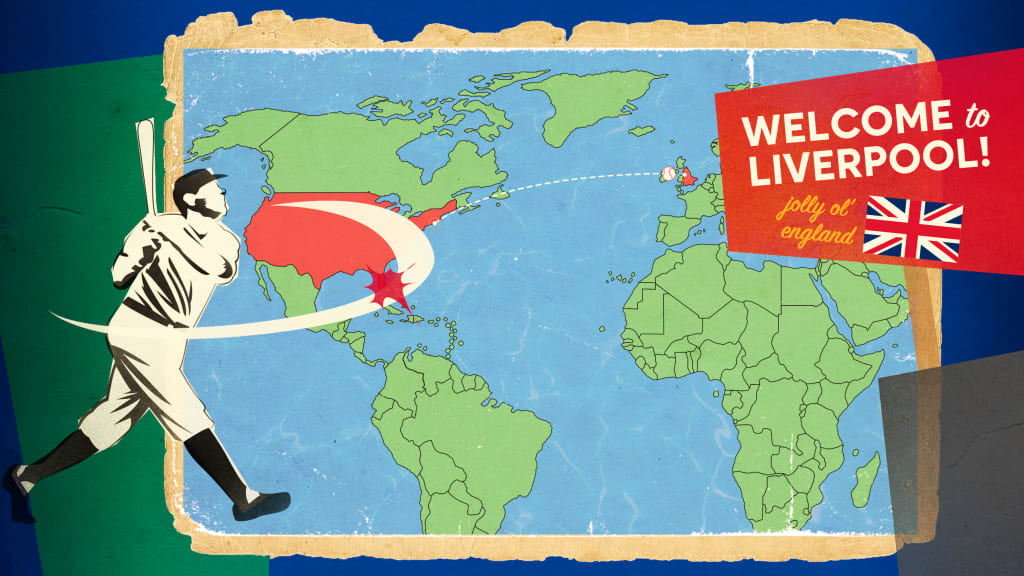
This story was originally published in January 2023.
Like most 19th-century baseball players, Jimmy Ryan had a fascinatingly bizarre career.
He was, by all recorded stats, a superstar.
The center fielder (born on this date in 1863) played for 18 seasons -- mostly in Chicago -- batting .300 11 times. He was an exceptional defender, and had something most hitters didn't have during this era: Power. He led the league with 16 homers in 1888 and, in 1900, became just the seventh player to reach 100 career home runs.
He hit .357 in 1894, a year after a severe train wreck shattered his legs -- an accident many thought could spell the end of his big league career. That same season, he saved fans from a fire at West Side Grounds by hacking an escape route through a barbed-wire fence with his bat.
If you don't believe me, just look at him. Tell me this isn't a guy that could, or would, do either of the above things.
But one Ryan story rises above the rest, and very likely above any story ever told in the long history of baseball: One day in 1890, "Pony" (as he was known), hit a 3,300-mile home run.
Ryan's Chicago team was in town to take on the New York Giants. Not at the Polo Grounds, but at Staten Island's shoreside St. George Grounds (the Polo Grounds were undergoing construction at the time).
The St. George Grounds, home to the polka-dot neck tie-wearing Double-A New York Metropolitans from 1886-87, was a sight to behold: Part of a family amusement area that included a resort along Staten Island's waterfront, the Grounds had a giant grandstand that included a wine cellar, bar and ice cream parlor. A casino was available to patrons on the backside. Fans seated behind home plate had unobstructed views of the game and the boats swirling around the New York Bay beyond.
There were also some interesting quirks on the diamond: Huge fountains, similar to Kauffman Stadium, were installed just behind the fences -- shooting 150 feet into the air, high enough to be seen from Manhattan. And during the '87 season, the Mets shared an outfield with productions of "The Fall of Babylon." Although ballgames and Babylon performances were at different times, the stage and set remained on the field for months at a time. As SABR's Larry DeFillipo noted in his profile on the Grounds, there were some moments when the two activities crossed paths.
"During a June 13 Mets loss, the visiting Cincinnati Red Stockings’ batters 'shot the ball against this stage, dropped it on top, and drove it over the top until it became a question of how long they could stand the fun.'"
But back to the 3,300-mile homer.
With New York and Chicago tied in the ninth, Big Jimmy Ryan came to the plate and blasted a ball clear over the fence in center field. It apparently not only went out into the ocean, but it hit a man standing on the bow of his schooner. He picked it up, held onto it and then sailed with it all the way back to his home in Liverpool -- more than 3,000 miles away. Here's more from the Wilmington Evening Journal account published years later. (This was a copy from a Baltimore Sun story that appeared just 10 days before.)
Yes, if you hit a ball across the Atlantic Ocean, you'd hold onto it and show it off for the rest of your life, too.
But really, could this all be true? A 3,300-mile hit? That bonked off a guy standing on his boat?
Although it was published in these two legitimate newspapers, you won't really find anything about it anywhere else. DeFillipo, who's done in-depth research on St. George Grounds, tends to side with common sense.
"It's a great story, for sure," DeFillipo wrote over email. "But impossible, in my opinion."
Besides the actual home run, DeFillipo points out that the rest of the story is filled with errors: Ryan played for the Chicago White Stockings, not the Chicago Pirates. He did hit a home run at St. George, but that was during the year before, in 1889. There were no pro games on Staten Island in 1890. There were also no center-field bleachers on "boards over the water." In fact, there were no center-field bleachers at all.
And the dinger, well, the way it's described in the article, would've had to have been hit astronomically far to get it out to the sea. Center field was the deepest part of the park. The Upper Narrows were about 1,500 feet from home plate.
If the report was mistaken and it was actually left field, it's still a momentous show of power. To hit a boat, it'd have to be up there with some of Mickey Mantle's fabled moonshots. Drawings of the diamond may make it seem like the Bay was close to the fence, but it most likely was not.
"The shortest distance for a ball hit fair from home plate to the shore line (down the left-field line, beyond the outfield fence and the adjoining railroad tracks) would've been 600 feet," DeFillipo told me. "... Add a few more feet to land on the deck, rather than hit the hull at the waterline, and the overall distance for a home run to reach the ship's deck would've been 610 feet or more."
So yes, a homer that traveled out into the ocean, hit a boat captain and traveled with him 3,300 miles from New York to Liverpool seems to have some inaccuracies.
But then why was it reported in these newspapers in such great detail? The paragraph about the letter being sent with the ball, and Ryan carrying it around with him? Ryan didn't hit a homer at the Grounds in 1890, but he did hit one the year before -- maybe the reports were about that one?
Although DeFillipo (and, let's face it, most reasonable people), would put Ryan's hit down as another 19th century baseball myth, he said he's doing a presentation on St. George Grounds at the Hall of Fame this spring and might unearth some new evidence of the event. He probably won't, but, also like most of us, he likely wants to believe that there was such a thing as a 3,300-mile home run. These are the mystical, apocryphal stories that make people fall in love with the game of baseball. It'd be much more fun if there was some tiny, infinitesimal chance it did happen.
MLB official historian John Thorn seemed to agree with that sentiment, responding in seven words -- and seven words only -- when asked about Ryan's homer.
"That fact is too good to check."
